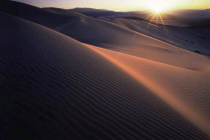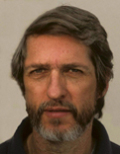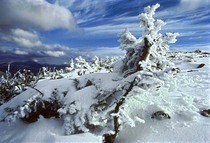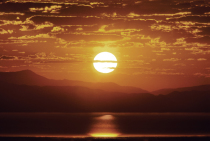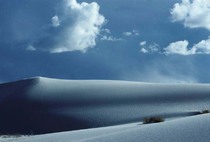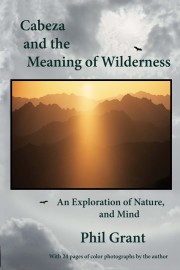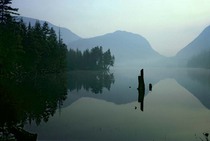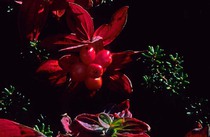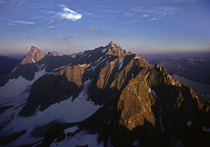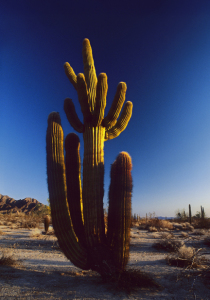
Welcome to meaningof wilderness.com, the home of Cabeza and the Meaning of Wilderness: An Exploration of Nature, and Mind, by Phil Grant.
© Philip H. Grant, all rights reserved
Free shipping on US orders. Click here to order through PayPal's SSL encrypted site (click checkout with PayPal, then click pay with credit or debit card), the safest way to pay online (your financial information goes directly to PayPal, completely bypassing this site). Click here to see all the photos, larger. For excerpts, scroll down, and also click here and here.
396 pages text (size: 6x9). 24 pages of color photographs by the author (see the Photos in Cabeza page; see also my piano/photo videos). Published by Desert Peak Press, list price, $18.95; online price, $15.99. Free shipping on US orders. Click here to order through PayPal's SSL encrypted site (click checkout with PayPal, then click pay with credit or debit card), the safest way to pay online (your financial information goes directly to PayPal, completely bypassing this site).
“Your descriptions of the desert are so vivid. . . . This is no ordinary book. . . rich with stuff . . . a page turner. . . .” D.F., Peekskill, New York (more readers' comments below).
Mounted and unmounted prints also available (detailed info at bottom of this page). Free shipping on all US orders. Click here to order prints.
Risk-free Purchase: If after perusing this site and purchasing Cabeza you find you are in any way disappointed, or feel the above quotes or or readers' comments below misrepresent the book, simply send an e-mail to phil@meaningofwilderness.com — with a copy of your purchase order attached, within 55 days of the date you placed the order. The full purchase price, $15.99 (free shipping in US)—will be refunded to your credit card . . . and YOU KEEP THE BOOK (applies to US orders placed through this site only). Because international shipping has become so expensive I am only offering a digital version of Cabeza, $15.99, outside of the United States. Click here to do so. Feel free to email us through the contact page if you have any questions or problems.)
Reader’s comments on Cabeza:
“The text as well as the photos are nothing less than captivating. . . . It is helping me shape in my mind the dreams I have to occupy the rest of my life . . .” M. V., Montréal, Québec
“Your descriptions of the desert are so vivid. . . . This is no ordinary book. . . . In addition to the search for meaning and beauty, Zen, the piano, you have biology and geology, environmentalism, suspense, how-to advice for long hikes in the wilderness. . . rich with stuff . . . a page turner.” D.F., Peekskill, New York
“Impressive book . . . enjoying it . . . exquisite photography.” D. H., Saratoga Springs, New York
“The writing and the photos are just superb.” J.T., Henrietta, New York
“Indispensable for understanding human beings’ place in the universe.” A. L., Nunda, New York
Comments on the photography (to see, click here) in Cabeza:
“Amazing,” S. B., Victor, New York
“Fantastic,” M. D., Garden City, Long Island
“Fabulous,” A.D., State College, Pennsylvania
Book Description:
Set primarily in the vast Cabeza Prieta National Wildlife Refuge of Southwest Arizona, Cabeza is a different kind of wilderness book. No “conquering” of mighty summits; no dazzling deeds of derring-do. While there is hardly a lack of summits, they are, rather, “caressed,” not conquered. It is a wilderness book where Nature is seen not as foe to be battled, but friend with whom one can just, simply, be. A companion to help one understand that the essence of a human being, “the ground of our being” . . . is profoundly rooted in its Source. It is a book about sitting so still an endangered Sonoran Desert pronghorn . . . walks right up. About spending nights on mountaintops with a view of the Whole thing . . . and a rising orange half-moon to befriend one at 3 a.m. About camping in a secluded, intimate canyon . . . and listening to the poor-will sing its plaintive, haunting, penetrating song . . . all night long. Poor will . . . poor will . . . poor will . . . poor will . . .
The interested reader may wish to peruse the three quotations from the dedication page below, the excerpts, and especially the 24 pages of photographs (posted at this site) by the author. Do those photos reveal Something, however ineffable? That is the focus of Cabeza: to convey Something of Keats’ Beauty-Truth and the author’s lifelong quest for the same. A quest to find freedom from Einstein’s “prison” of self; to find the freedom to “embrace all living things and nature in its beauty”; to find the freedom to allow, in Carl Sagan’s words, “the Cosmos to know itself.” With a liberal dusting of wit, a sprinkling of self-deprecation, a sparkling and unexpected wry humor, and a conversational tone that magically engages the reader, Cabeza gently leads us “off trail,” into the wilderness of Nature, and into an ever-deepening understanding of what a human being really is.
Dedication page quotes:
A human being is part of the Whole, called by us ‘Universe,’ a part limited in time and space. He experiences himself, his thoughts and feelings as something separated from the rest—a kind of optical delusion of his consciousness. This delusion is a kind of prison for us. . . . Our task must be to free ourselves . . . to embrace all living creatures and the whole of nature in its beauty. —Albert Einstein
We are a way for the Cosmos to know itself. . . . that Cosmos, ancient and vast, from which we spring. —Carl Sagan.
Beauty is truth, truth beauty—that is all / Ye know on earth, and all ye need to know. —John Keats, "Ode on a Grecian Urn."
The goal of Cabeza is to embrace the entirety of the human condition. As one Zen "master" put it, “What is truth? I will tell you after you have swallowed all the waters of the West River in one gulp.” It is about what could be termed genuine spirituality. If it has a target audience, it is for intelligent, thoughtful readers with an appreciation of the natural world. Amidst chapters deeply evocative of the sublime beauty and perfection of nature are those discussing evolution (Cholla I and II), meditation (its meaning and profound scientific underpinning), the greatest works of music and art, neuroscience (The Unfree Will), and quantum mechanics and relativity (And the Stars)—presented in a readily accessible and engaging manner—all of which point to the truth of Einstein's words: “A human being is part of the Whole . . .” It could be said that the whole purpose of Cabeza, throughout its perambulations—some lighthearted, others of deepest seriousness—is nothing less than to bring this truth and all its ramifications to the forefront . . . and to keep it foremost in the reader's mind. (To read more about meditation and the "meditative" mind, the Mind that takes in the Whole, in Cabeza, click here.)
Excerpts from Cabeza and the Meaning of Wilderness:
From Chapter 1, "In the Beginning"
But if one day . . . you went astray. Off the freeway . . . off the highway . . . and followed the dirt road
. . . then the jeep road . . . as far as you could. Then crossed on foot the rough rock-strewn terrain; tall saguaro here, blooming stand of ocotillos there . . . on a low white ridge striped with black. If you followed a wash . . . up a steep-sided, twisting, turning, winding, climbing ravine cut deep into the flanks of—call it Sheep Mountain for the desert bighorns that are up there, somewhere, you knew they must be. Past what seemed small palms: the soaptree yucca with its three-foot narrow pointed leaves radiating from the crown, all swaying with every breath of air. Then carefully around the low-growing agaves with their similar but firm leaves, dagger sharp and dangerous, yet a beautiful blue-gray green. Agave: the “century” plant. After years and years of slow, determined growth, finally sending forth a twelve-foot stalk to flower, and spread its seed . . . and dying with the effort.
And then, if on you clambered . . . over the red and gray boulders fallen from the towering crags above . . . or on the smooth streambed rock—so smooth you almost fell—polished and burnished from the torrents that cascade down these slopes every ten? . . . hundred? . . . or more? . . . years. But unimaginable in the day’s dryness. . . . Enclosed by walls of granite into your own private little world
. . . of rock . . . and sky . . . and sparse desert vegetation. A world perfect . . . whole . . . and complete.
And then, if then . . . you caught a glimpse of the tiniest things: a pair
of Costa’s hummingbirds, half the size of the eastern ruby-throat . . . flitting back and forth . . . hovering around your head . . . just out of reach. And then . . . you saw it.
Dangling . . . swinging . . . gently . . . on the end of a mesquite branch stretched almost across the steep gully. Smaller . . . than your palm.
Swaying . . . to and fro . . . to and fro . . . to and fro.
A nest.
And two miniature eggs within.
Maybe . . . maybe then you’d understand. And maybe not.
From Chapter 3, “Mountain Lion!”
. . . Since I had also developed a nasty sore on my back due to my new pack’s poorly designed, or poorly assembled, hip belt, we opted for day hikes, camping in the perhaps illusory safety of the
mini-camper. The mobs and mobs of houseflies ubiquitous that year, due to recent rains, helped induce us not to regret our decision. So we drove up the road a bit until we found, at the top of a
small rise, the perfect spot: hard packed “desert pavement” to park on beside the road, and a fine view of gently rolling hills and desert off to the Sierra Pinta. Chollas, saguaros, ocotillos, plus
blooming brittlebush, creosote bushes, and palo verde trees filled in the foreground. Truly the Whole Shebang right before our very eyes. After the trip we sent a so-entitled photo to a friend and
received the reply: “The picture of the desert is superb. It must be total peace in those areas.” Yes, yes . . . if only you could—click—delete the bugs. As someone once put it, it’s hard to believe
in a loving God who invented mosquitoes. And flies. And gnats. And . . . whatever. Then again, that Mind (whatever IT is) also invented the human mind, which in turn invented no-see-um netting, so. .
. .
Anyway, not that bad a “base camp” for the upcoming—Summit Assault! After the next morning’s photo op, and our usual session of just taking it all in (with tea, of course, and a slew of exceedingly frustrated flies coating the screen) we headed out, in complete Silence (excepting the buzzing flies), through our—benevolently?—bequeathed wonderland, wandering towards the minor peak a few miles off that was the objective du jour. And I should here mention that while there are no trails in Cabeza, if you’re comfortable with map and compass then you can wander virtually wherever—this enticing wash, yonder alluring ridge, that saguaro-studded valley. Wherever . . . the heart desires, or the mind inclines, or the soul yearns.
The summit was adjacent to a peak we had climbed our first magical “discovery” year. That time, after hiking across wash after wash filled with orange desert globe mallow, we had scaled the mighty prominence, or rather mighty mound, giving us our first panorama of the refuge. To the east had lain the vast ocean of desert: mostly a dry and gray, utterly flat, vegetation-speckled expanse with a further range on the horizon. But to the west, with its mountain- and hill-jumbled terrain, had been different. Every slope had caught and funneled that winter’s uncommon rains down into every arroyo, every dry creek and streambed, every wide wash. And the globe mallow, seeds long awaiting this moment, had sprouted, thrived . . . and bloomed. Down every narrow channel they had “flowed,” then joined with other channels, and others, and others . . . ever, ever widening into a veritable broad river of pale orange with all its tributaries, inexorably sweeping into, and ultimately subsumed by, the almost barren eastern “sea.”
The current year was more normal as only sparse rain had come far too late,
of benefit to none but the flies. The vista was far less dramatic. But still okay. Very, very okay. We relaxed, having caressed, if you will, rather than assaulted, our summit. A welcome breeze
kindly dispersed the flies. Then we started back, circling to the truck by a different route. And in the sand, under a palo verde tree prospering on an “island” in a dry riverbed, we saw it. A track.
We weren’t, then, 100% sure. We examined it carefully. Could it (please) be a coyote? But back at the truck the guidebook confirmed our trepidations. What we had seen—the heel pad plus four toes—had
been quite round. Coyotes’ are oval. It had been about four inches in diameter. Coyotes’ are two and a half. We had seen no claw marks. But coyotes do not retract their claws. Yup, everything
fit.
Well, big deal. They’re all over the West anyway, and moving east. They’re shy, and don’t like us humans who are by far the most dangerous species on our orb. . . .
From Chapter 10, "Three Vignettes"
It was the summer of ’73. The day before I’d made the long trek down to the desert in Owens Valley to retrieve a buried food cache. Now back high in the Sierras, after following the John Muir Trail for a few hours, I branched off the beaten track, as is my preference, across high and open country. Later in the day a strong gusty wind came up and dark clouds menaced, so I decided to make camp on the only spot available: a slightly tilted, sort-of-flat rock. After a mighty struggle with the wind-whipped tent, tying it down to small boulders, finally I was done. But just as I settled in with a hot cup of tea to relax and enjoy the storm . . . darn it all . . . the wind died, the clouds dispersed, and the sun came out! With an easy peak beckoning to the east and a full moon on the way, there was nothing to do but put my boots back on . . . and head up. Two-thirds up I looked back and beheld . . . the few remaining clouds drifting across an immeasurably vast space . . . the windswept surface of the lakes far below . . . and a ruby sun nestling gently into a notch in the distant peaks . . . and took a photograph . . . of the Whole thing. On the summit, with hardly a breath of wind, I sat for a few hours . . . surrounded by mountains, lakes, and an infinite array of stars . . . waiting for the moon to rise high enough to guide me down.
I didn’t need my flashlight.
From Chapter 21, "The Heart of Cabeza"
. . . Life . . . is beautiful. Can be seen as beautiful, when one has the luxury not to be constantly battling to survive. Anne and I appreciate and see that beauty especially well in the desert and at high altitude where life is hard and sparse. A field of flowers is beautiful. A single flower sprouting from a crack of a vertical high rock . . . even more so. I once had a friend I will call Crazy Laurie—because she was, but. . . . I showed Laurie the first pictures I ever took, in the Sierras, and we came to one of a few red flowers surrounded by cold, hard, gray-white granite.
“Oh Phil, Phil, Phil,” she cried. “That’s it! That’s it! That’s what life is! That’s what we all are! A tiny flower surrounded by rock. A tiny flower growing from the rock. Oh Phil, Phil, Phil! God made you take that picture for me!”
I made her a big enlargement. . . .
And I don’t think I can disagree with Crazy Laurie. For all I know, maybe God did make me take that picture. Something made me take that picture. There was Beauty and Truth there. Genuine beauty. Not the artificial, feel-good, comforting allure of some constantly tended, human-designed garden. (Aren’t gardens a constant battle against bugs, drought, weeds, and animals?) And genuine beauty is . . . Truth. It is . . . a revelation . . . of what, perhaps, we cannot say. Of That . . . which is beyond all words. So “Crazy” Laurie did see . . . that life is beautiful . . . on our pale blue dot called earth . . . floating in an otherwise overwhelmingly hostile universe. A tiny flower surrounded by rock. A tiny flower growing from the rock. Yes.
* * *
The Photos: At this time, to view the photographs, click here. If you have dial-up it may take five or ten minutes or more to load, so make a cup of tea or coffee or have a beer and relax. All of those 25 photos are in the book. In the future I may post more and try to make the process a little less cumbersome. All of the prints offered at this site are printed on Hahnemuhle smooth fine art paper, or similar. Frankly, they are stunning -- far better than any I've ever had made at a commercial lab. I love the fine art paper because there is no gloss or glare whatsoever, and the photo ends up looking like a fine painting.
Although I worked hard adjusting the proofs in the book, and I can say the photos came out quite well there, they just do not compare with the ones I can print at home on this fine printer.
I offer three sizes of framed prints: an 8 x 12 (with no surrounding mat board) in an 8 x 12 black matte metal frame; a 10 x 15 print surrounded by a 16 x 20 mat framed with a black matte metal frame; and a 13 x 20 print surrounded by a 20 x 26 mat and a 20 x 26 wooden frame that is approximately three quarters of an inch wide and painted matte black. Archival mat board and foam board (the backing) are used, there is no glass; the prints (and mat board) are protected by three coats of Premier Printshield spray which has been rated by the independent Wilhelm Research Institute (www.wilhelm-research.com) to protect as well as glass against ultraviolet rays, moisture, and pollutants. It does not protect against physical damage. (The spray does protect to a degree against abrasion. I've scraped my thumbnail across the surface, and the sprayed prints definitely hold up better. In most cases, it should be possible to gently wipe off any spots -- I have successfully done this as a test, but otherwise I've never found it necessary.) I do not use glass for the following reasons: 1) For shipping purposes, I would have to buy fancy boxes to make sure it didn't break. 2) I just do not like glass. (Plexiglass is even worse since it scratches easily.) There is always a reflection, even when using the much more expensive "nonreflective" glass. There is a tangible separation between the viewer and the image that I cannot bear. For many years I have been mounting photos without glass and without a problem. If you wish to dust them, just use a feather duster, or the equivalent synthetic (Wal-Mart, $1.47). Glass may be added if desired; use single strength window glass -- hardware stores in an area with older homes sell this for $4-$9. You may also buy unframed prints 10 x 15, and 13 x 19, which are not sprayed, and frame them yourself however you wish. (Click to order here .)
* * *
Phil Grant is a writer, photographer, classical pianist, and wilderness explorer, of Nature, and Mind. He lives with his wife and hiking buddy, Anne, an artist of abstract watercolor, in upstate New York.
